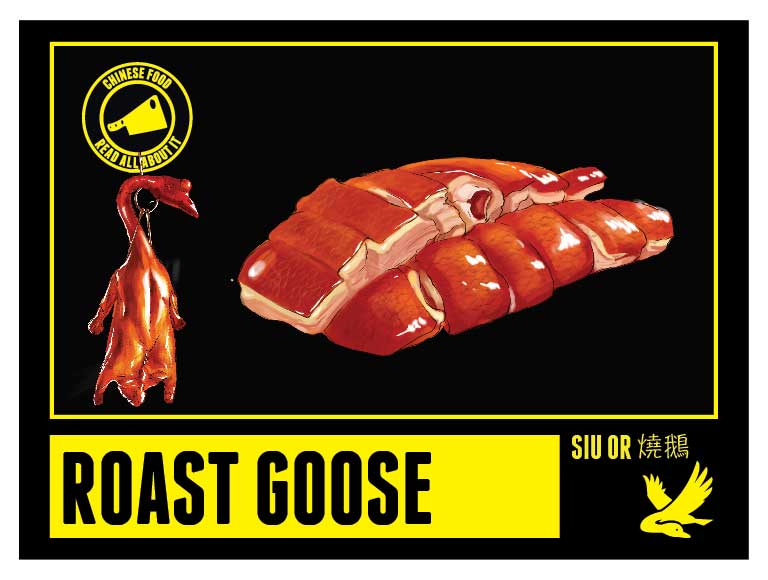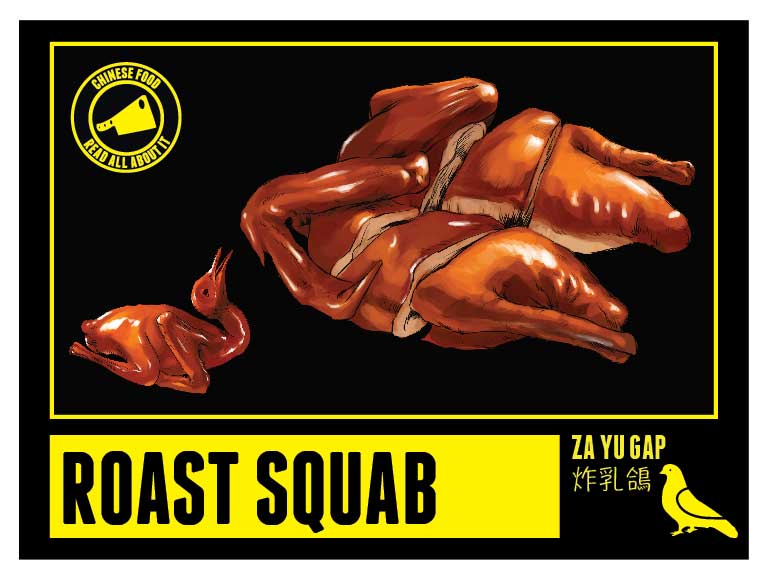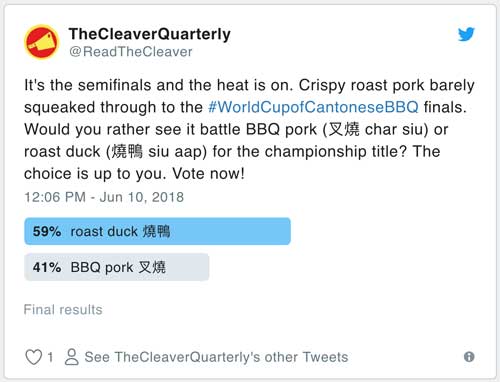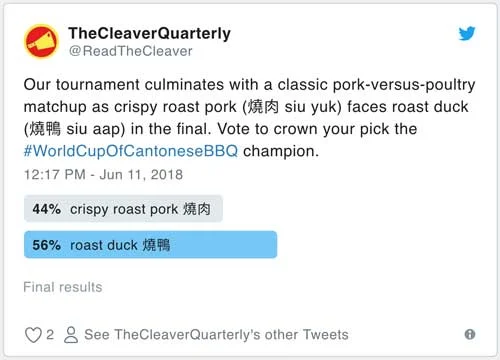The World Cup Of Cantonese BBQ
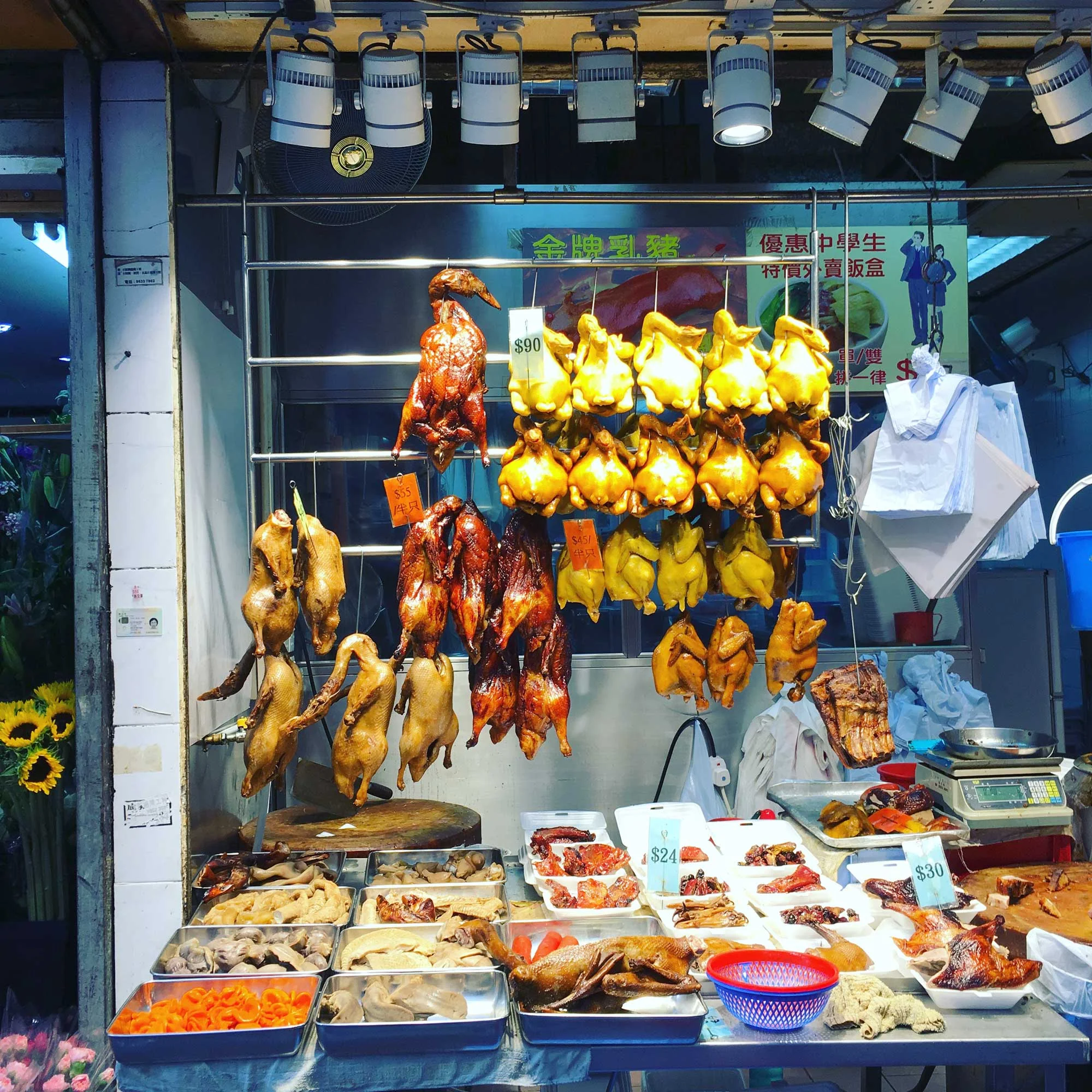
Fifteen meats and a squid enter. Only one will emerge victorious. Welcome to The World Cup of Cantonese BBQ.
THE TOURNAMENT
Can we agree that one of the best things about Cantonese food is the fantastic array of roasted meats? Nothing says Chinatown like a BBQ meat shop, where glistening ducks and chickens dangle next to ruddy slabs of pork – all within arm’s reach of the butcher who will roughly dismantle them with a few expert chops.
To properly celebrate these glorious meats, The Cleaver Quarterly hosted the World Cup of Cantonese BBQ to determine which juicy, savory meat was truly king.
All matchups were conducted via Twitter poll, with one vote per Twitter user; each poll remained open 24 hours. Our 16 meaty contenders were randomly assigned into four groups of four. The group stages were contested in four-way polls, with ties decided by a byzantine cross-channel point-based index. The quarterfinals pitted the victors against runners-up from neighboring groups, with winners advancing into the semifinals, and from there to a thrilling final contest where the two meats deemed most popular by our audience battled it out for supremacy.
Below, you’ll find a handy wallchart that displays tournament results at a glance, but for a spoiler-free experience, scroll past and start reading from the group stage previews, which give a sense of how the meats stacked up against each other at the outset. Our in-house football pundit assessed all 16 contenders, telling us which World Cup soccer team each meat most resembles. Then we broke down the edge-of-your-seat action as it unfolded into a tournament for the ages.
GROUP A
The tournament kicks off with a challenging group: not one but two popular cured meats (Chinese bacon and wind-cured duck) squaring off against a minimalist classic (white-cut chicken) and a finger-licking fan favorite (roast spare ribs). Will brash saltiness win out? Will subtlety pass muster? Which two meats will emerge from this group for a chance to vie in the quarterfinals?
WHITE-CUT CHICKEN (白斬雞 pak zam gai)
“As far as my mom (and 5 out of her 8 siblings are concerned), White-Cut Chicken is the ultimate gauge of an eating establishment’s quality, experience, talent, and panache. It’s a minimalist’s dream, a simple poached chicken served with a dipping sauce that contains only four ingredients. You can tell how fresh the bird is by the firmness of its skin. Flabby skin that falls off the meat equals frozen chicken and lots of disapproving aunties and uncles!”
– Mara King (Ozuké)
“White-Cut Chicken: The yin to Soy Sauce Chicken’s yang, this ‘white cut’ contender shows off with its bare-faced beauty – a paean to the principles of classic Cantonese cuisine where the true flavour of the bird is left to shine. But it also has one more secret weapon – its rugged ginger scallion bedfellow that takes it to another level.”
– Charmaine Mok (T.Dining Hong Kong)
Compare to: Sweden
Classic, light, clean and minimalist: just like Sweden’s team. Both are old-school and may have peaked in the past – their only appearance in the World Cup final was back in 1958, when they came up against a Pele-inspired Brazil. Also, the pink poached meat and the ruddy-cheeked Swedes are similarly unencumbered – the simplicity of the chicken and the uncomplicated fact that Zlatan Ibrahimović has retired. People might worry they are undercooked for the same reasons.
CHINESE BACON (臘肉 lap yuk)
Dry-curing pork belly turns a soft slab of streaky meat into a greasy, dark, and weathered cudgel. The curing process operates like a remarkable compression algorithm for umami. Here is your zip file for pigginess. Would you like to extract all the original flavors? Yes, please. Over steamed rice.
Compare to: Spain
Streaky in the sense that they went and won the European Championship, World Cup and then another European Championship, the Spanish are also masters of the pork. Much like the taste of Chinese bacon, they always feature a squad of frightening density. They have plenty of skin in the game.
WIND-CURED DUCK (臘鴨 lap aap)
These ducks are spatchcocked, marinated with rock salt and wine, then air-cured until the flesh takes on a rosy tint. High-sodium, high-fat, and habit-forming: a few chunks of this ultra-savory meat can turn you into a rice serial-killer, dispatching bowl after bowl with no mercy.
Compare to: England
Fittingly for a World Cup, lap aap involves getting soaked in alcohol and left outside, the purview of many soccer supporters – especially the English. Spatchcocked is just another word for flattened, which aptly describes the hopes of the English – but with the wind at their back, there is always a chance. Maybe the referee will blow for a fowl?
ROAST SPARE RIBS (燒排骨 siu pai gwat)
Wherever there’s bone, there’s the promise of connective tissue: sinewy and fatty bits, gristle, and cartilage. For Chinese gourmands who adore textural variety, bone-in is a clear bonus. Roast spare ribs is for everybody who likes char siu but wants to get more hands-on.
Compare to: Uruguay
The chewiest of meats compares to the chewiest of footballers: Uruguay’s serial-biting, close-to-the-bone striker Luis Suarez. The gnawing feeling that he might stick a sucker punch to the ribs is one that many World Cup opponents know all too well and Suarez’s love of feeling texture between his teeth is second only to Chinese diners. If the ribs don’t glaze over, they could go deep into the knockout rounds.
GROUP B
This group features the Battle of the Pigskin, with crunchy roast pork circling its youthful doppelganger, roast suckling pig. Both are enormously popular, but the latter is a special-occasion treat while the former may benefit from familiarity. Meanwhile, don't take your eye off roast goose, which is lesser-known overseas but has a fervent following in Hong Kong and southern China. The odds look slim for marinated orange cuttlefish in this competitive group; it can only hope the two piggies siphon off votes from each other, opening the door for an upset.
ROAST GOOSE (燒鵝 siu or)
The uninitiated often mistake goose and duck, but if you can’t identify roast goose by its longer neck, its beak bump, or the conspicuous layer of fat under the crisp skin, you probably deserve to pay goose prices for duck. Unscrupulous BBQ shops in Guangzhou have been known to disguise duck as goose; they rely on the literal truth of the Chinese idiom that only dummies can’t tell the two birds apart (鴨鵝不分 ya e bu fen). Get your hands on the real deal: a plate of roast goose, smoky from the charcoal oven, juicy and self-basted by its own fat.
Compare to: Ireland
Widely adored, who else but Ireland for the goose? Especially because many people confuse the goose for the duck, much like the Republic of Ireland and Northern Ireland can be confusing to those who see a green shirt and look no further into the peculiarities of European geography. In Chinese poetry, geese may symbolize unjust exile – something that Ireland knows all too well at the hands of Thierry Henry, and Northern Ireland knows this year at the hands of Switzerland.
ROAST SUCKLING PIG (燒乳豬 siu yu jue)
Pure showmanship, from its glossy skin to its glowing cherry-red eyes. As a high-status offering with enough meat to feed everybody, suckling pig is the perfect celebration food: borne aloft and greeted with applause at anniversary banquets, grand openings, film premieres.
“Next-level technique comes with the roasted suckling pig – with its shatteringly brittle skin and succulent meat … I mean, it’s out of control.”
– Abe Conlon (Fat Rice)
Compare to: Brazil
Celebration food fits with a team that have had the most celebrations, and the Boys from Brazil are also known to have enjoyed a barbecue in their time. Often extremely youthful and known for its shellackings, both Brazil and roast suckling pig comes out to deliver joy on the big occasions. Something for everyone and a firm crowd favorite.
CRISPY ROAST PORK (燒肉 siu yuk)
“For my money, that Macau-style pork belly though. When it’s done right, those seven layers of fat and meat, crunchy puffed skin, dipped in a little sugar, ooooh-weeee, heaven! Make you wanna slap your A-Ma!”
– Abe Conlon (Fat Rice)
Compare to: Scotland
Brawny, rugged, and with a well-crackled skin, crispy roast pork is Scotland. A staple of the ’70s and ’80s but not much seen since the late ’90s, this is a classic that’s best enjoyed with a novelty song and wig alongside a can of lager.
MARINATED ORANGE CUTTLEFISH (鹵水墨魚 lo sui mak yu)
Marinated meats and offcuts are a staple of the BBQ meat shop, but most of them didn’t make the cut for our World Cup of meats. So what makes the cuttlefish so special, repping not just its braised lo sui brethren but also the entire ocean? Perfect timing, for one thing. The cuttlefish start off snowy-white, but their dip in the master stock (replete with five-spice, scallions, ginger, clove, cinnamon, and nutmeg) gives them that garish double-take hue. Like all seafood, they have the potential for great tenderness but an extra minute or two can make the difference between tantalizingly toothsome and rubbery.
Compare to: Australia
Seafood in a meat shop is an indication that you’re out of your depth. Despite not being a traditional soccer nation, Australia is once again at the World Cup. The coastline-rich country even wore a gold kit to the 1974 World Cup in Germany that mashed up the three stripes of Adidas and the double diamond of Umbro, who were in business together at the time. If that image isn’t as clownish as a cuttlefish, then who knows what is? Plus, an order of cuttlefish can feel as expensive as supporting the Socceroos away.
GROUP C
No one said the World Cup of Cantonese BBQ was going to be easy – but this group does feature a few underdogs and no clear favorites. Gold coin chicken has a lock on the nostalgia vote but its obscurity may doom its chances. Roast squab is no everyday item either, but it will likely benefit from its association with lavish banquets. Meanwhile, Chinese sausage is famous worldwide but does it inspire passion? Of all the contenders, salt-roasted chicken – both mouthwatering and easily accessible – may face the best odds. Only two can advance; the others are sure to be butchered along the way.
GOLD COIN CHICKEN (金錢雞 gum chin gai)
“So few shops that still make gold coin chicken that it has a kind of mythic quality. I love that there’s no actual chicken flesh in this dish either. It's named after the round shape and the hole left from the skewer that resembles antique gold coins on a thread. On a long skewer, pieces of pork fat are interspersed between pieces of pork and chicken liver, then cooked over coals. The fat ends up crispy, the liver tender and fleeting, and the meat juicy, porky and full of flavor from its skewermates. This has to be the unicorn of Cantonese BBQ and I shan’t rest until I’ve tracked it down and wrestled with it at least three times!”
– Mara King (Ozuké)
Compare to: Netherlands
A ragtag mix of delicious greaseballs? Hello, the Netherlands and in particular the 1990 vintage where Frank Rijkaard … well, let’s not mention that. The spit we want to talk about is the one that gives the “gold coin” their name, the skewer perforation that makes them look like ancient Chinese currency. The real-life Netherlands’ own golden days also seem ancient history, just as gold coin chicken has its heyday in the past – but are they too due a comeback? The choice of aficionados.
SALT-ROASTED CHICKEN (鹽焗雞 yim gok gai)
This classic Hakka dish involves sealing up a whole chicken and its good juices in wax paper, burying it in coarse salt, which allows no moisture to escape, and then roasting away. It’s like the Hero’s Journey if the hero were a chicken and their descent into hell involved a spell in the salt mines. Submerged in hot rock salt, they smoulder and wrestle with the ghosts of other chickens. They emerge transformed, panting, delicious.
Compare to: Iceland
Did somebody say Hakka? Perhaps folks are more familiar with “haka” – the Maori celebratory dance that New Zealand sports teams perform to honour their own indigenous population. While the All Whites are not playing in Russia this summer, the World Cup does feature another team who are just as friendly, loveable and known for a dance that celebrates their culture: the Viking clappers of Iceland. If salt-roasted chicken can be described as a heroic trip to the underworld, then where else but the ethereal, haunting beauty of Iceland?
CHINESE SAUSAGE (臘腸 lap cheong)
These waxy wrinkled batons are sweet enough to qualify as meat candy. Composed with lashings of antimicrobial salt and sugar, soy sauce, and liquor, Chinese sausages serve as a strategic flavor reserve. Once you turn up the heat (in a claypot filled with freshly steamed rice, perhaps?), you can observe the tastiest kind of oil spill. With their incredible richness, a little can go a long way, which is why the sweet fatty sausage also makes a brief but memorable cameo in dim sum and stir-fries.
Compare to: Hungary
Shamelessly fat-positive, these Chinese sausages are a mix of lardy fat and pork (and sometimes duck liver). It seems a fair comparison to pair them with the Galloping Major Ferenc Puskas and his Magnficent Magyars, the stocky Hungary team of the 1950s that lost the 1954 World Cup to West Germany despite having beaten them 8-3 in the group stages of the same tournament. Sometimes it’s hard to manage second helpings.
ROAST SQUAB (炸乳鴿 za yu gap)
Here’s what you do: You catch an unfledged pigeon (full-size but pre-flight); you braise it in a bath of soy sauce, vinegar, rice wine, and spices; you dry it and then plunge it into hot oil; you slick the crisp skin with maltose or honey before serving. The easier way: Just finagle an invitation to your Hong Kong auntie’s big anniversary dinner. Submit to having your cheek pinched, and then pinch a crisp pigeon from the lazy susan. A bird in your hand is worth two in the kitchen … but if you’re ravenous, maybe you can polish off those two as well? Some diners grapple with the tiny bones, while others fee fi fo fum their way through the entire bird, crunching the wings, beak, all of it.
Compare to: France
The French football team is as enigmatic as one might reasonably expect and they’ve been known to squabble amongst themselves. When they are not doing that, they can serve up gourmet football, much like these glossy little birds are often the highlight of lavish banquets: wedding, birthday, New Year, or World Cup. Small in stature, compact, and bewilderingly brittle – they’re a delicacy that can make quick work of anyone when they are on song.
GROUP D
Every World Cup has a “Group of Death” and ours is no exception. Who could have predicted that the odds-on favorite char siu would compete against the beloved roast duck this early in the tournament? And don't sleep on soy sauce chicken either, as this bird inspires the kind of devotion that keeps foodies awake at night. That leaves only smoked pork hock, whose chances of elimination here are the closest thing to a sure bet as you’ll find.
BBQ PORK (叉燒 char siu)
“The discipline of cooking HK BBQ is in the slow cooking and drying and having patience and proper timing and all those things that make BBQ great. Its reward is that perfect rendering of fat, and watching the juices slowly run down the meat as it hangs in the window, and of course the taste after it’s hacked on that uneven butcher block and scooped up by that cleaver and placed on a warm bed of rice with a touch of sauce. All the juices and fat mingle with the rice, the meat perfectly moist inside and crisp on the outside. Char siu roast pork is the standard in which great BBQ houses are measured and should be considered the favorite in this competition.”
– Chris Cheung (East Wind Snack Shop, Tansuo)
Compare to: Germany
The clear favorite. Just as many Chinese fans will be supporting World Cup holders Germany this summer, char siu is the most popular of barbecued meats. Even the English translation of its name (“fork-burnt”) sounds like a pair of Teutonic surnames. To paraphrase former England footballer Gary Lineker: “The Barbecue World Cup is a game played by 16 meats and at the end char siu wins.”
ROAST DUCK (燒鴨 siu aap)
“Red, gold, and glistening crisp skin, shiny with the promise of delicious rendered fat ready just underneath, a perfect complement to the juicy, earthy, dark brown meat hidden below. Sumptuous sweet plum sauce and a bed of beans resting beneath it all waiting to be plucked and savored in singular fashion.”
– Mara King (Ozuké)
In Peking, they fetishize the skin to the detriment of the meat, but the Cantonese never forgot the succulence of duck. Gamy and flavorful, this is roasted meat to sink your teeth into. Ducks work all their muscles to fly; their padding of fat helps them float. In the heat of the charcoal oven, these evolutionary advantages translate into self-basting dark meat.
Compare to: Portugal
Rich, game, succulent and good enough to eat. That’s (probably) not how Cristiano Ronaldo describes himself but rather a summary of the highlights of the best roast duck outside of Peking – in this case, despite the star skin, the meat (or is that team?) comes first.
SMOKED PORK HOCK (熏蹄 fan tai)
If we were attempting to describe this meat – sight unseen – to a French chef, we might call it a ham hock roulade with the textural variety of a terrine or galantine. In other words, it’s a self-layered ham with frills and piping, a pig’s foot made boneless and sumptuously easy to eat. Or maybe it’s enough to say that one bite will give you all the mouthfeels: meat, tendon, fat, skin.
Compare to: Italy
Like revenge, this is a dish that is best served cold. This chilled meat simply couldn’t be more World Cup-ready: It is literally a foot. Also, hails from the town of Foshan, the home of many famous kickers: Wong Fei-hung, Ip Man, Bruce Lee. In football terms, this reminds us of Italy, where the word for the beautiful game is not just a literal translation of “football,” but rather calcio or “kick.” The standard dipping sauce – a sweet garlic-chilli concoction – adds another kick of its own.
SOY SAUCE CHICKEN (豉油雞 see yow gai)
“My love for Soy Sauce Chicken resonates from a place of deep joy. It’s a fire that was lit for me as a child when my mom would make soy sauce chicken wings at home and we would devour them, being mindful to drizzle the sweetened chicken fat-laden soy sauce all over our pearly short-grain rice to prolong the animal exuberance of tearing chicken wings bone from bone, and gnawing off every little bit of soft, unguent, sweet and salty skin.”
– Mara King (Ozuké)
“Soy Sauce Chicken: Sweet, salty, and deeply complex – a glossy, burnished chicken with its contrast of ivory meat and sultry soy-tinged skin is the thinking eater’s choice. With its delicate balance of spices, sugar and soy infusing the bird, this is one of those dishes where discarding of the skin is tantamount to committing treason.”
– Charmaine Mok (T.Dining Hong Kong)
Compare to: Argentina
As classic as the blue and white stripes of the Argentina kit, soy sauce chicken is also as simple as that design. As a staple of the home cook, it is always around, even if that means it isn’t top of the table at the special occasions. Plus, with the slurpable sauce things can get a little Messi – and that is a pun we make no apologies for.
GROUP STAGE POSTMATCH ANALYSIS
White-cut chicken pulled ahead to an easy lead in Group A. For most of the match, wind-cured duck and roast spare ribs vied for the second berth, with Chinese bacon languishing far behind. Suddenly, in the final few hours, Chinese bacon muscled ahead and pulled even with wind-cured duck and roast spare ribs. Thanks to the cross-channel tiebreaker points, Chinese bacon scraped past the group stage by the skin of its belly, and faces a brutal quarterfinal against a crowd favorite: crispy roast pork.
In Group B, the lonely squid (鹵水墨魚 lo sui mak yu) on which rested the hope and dignity of the entire lo sui clan, never found its footing. Roast suckling pig and crispy roast pork traded the lead for the first half of the match, but a late surge by roast goose to the runner-up slot left crispy roast pork as the group winner and shattered the glossy hopes of roast suckling pig, a celebration meat that had been considered by many a potential cup-winner.
Gold coin chicken – the skewered meat, fat, and organs our pundits dubbed the “unicorn of BBQ” – defied expectations by sprinting to an early and sizable lead in Group C. By half time, Chinese sausage and salt-roasted chicken had drawn even; they ended the match tied for the win. The tiebreaking point differential tipped Chinese sausage into the winner’s slot, although as runner-up, salt-roasted chicken will face an easier quarterfinal opponent due to a stunning upset in Group D.
The contest in our Group of Death lived up to its billing. Lucas Sin (Junzi Kitchen) made an impassioned defense of the “impossibly delicate” soy sauce chicken as the discerning eater’s choice, saying, “You can cheat your way to delicious barbecue: sexier cuts (jowl or pork belly) for char siu, heavier five spice for ribs, or tea smoke for roast duck. But you’ll never cheat your way to a perfectly soaked soy sauce chicken.”
When push came to shove, however, the braised fowl couldn’t stand the heat – but roast duck could and did, keeping pace with char siu, the tournament favorite. Roast duck ended the match with an explosive eleventh-hour push that hammered the dazed char siu into the runner-up position, and set the stage for pork-on-pork, poultry-on-poultry quarterfinals.
QUARTERFINALS POSTMATCH ANALYSIS
With white-cut chicken’s group stage blowout tarnished by a ginger-scallion doping scandal, the poached bird opted to play it safe in its quarterfinal against roast goose (燒鵝 siu or). Fielding a cautious defense against the larger, crispier opponent kept the match competitive through the first quarter, but by halftime roast goose had carved out a narrow lead that held to the last buzzer. The observation from pundit Chris Cheung (East Wind Snack Shop, Tansuo) that white-cut chicken “is deeply symbolic, used widely to honor our ancestors as an offering” proved sadly ironic, as the austere chicken ended up kowtowing to goose.
In the first minutes of the second quarterfinal, heavy underdog Chinese bacon played against type by cranking up the heat on crispy roast pork (燒肉 siu yuk), seizing an early lead. Pundits agree Chinese bacon would have been better served by playing to its strengths of toughness and resilience. Siu yuk, no stranger to bright lights and blistering temperatures, came alive under the pressure and hung Chinese bacon out to dry.
If past performance is any indication, crispy roast pork should enjoy a clear path to the finals. All that stands in the way is a rematch with roast goose, which advances to the semifinals with soaring confidence from hard-earned wins over suckling pig and white-cut chicken, and seeking vengeance for its group stage loss to crispy roast pork. But has goose’s gleaming, scrumptious armor remained intact through the bruising matches to date?
BBQ pork (叉燒 char siu) entered the third quarterfinal with a chip on its shoulder from its group stage loss to roast duck, and proved it by mercilessly slicing and dicing lap cheong 臘腸, the wind-cured sausage that Charmaine Mok (T.Dining Hong Kong) eulogized as a “misunderstood beauty,” and “the art house flick to char siu’s blockbuster hit.”
In the fourth quarterfinal, roast duck (燒鴨 siu aap) exploded into action as if it had been startled from a backwater slough, establishing an early lead that it never relinquished. Steamy salt-roasted chicken (鹽焗雞 yim gok gai) did win points for technique, with Chris Cheung calling its savoriness “otherworldly,” but in the end its support crumbled like rock salt. Duck partisans are celebrating tonight. Call it “V” formation for victory.
The upcoming semifinal between char siu and roast duck is a dream matchup. The two meats, so often paired up on a combo rice plate, now go head-to-head. BBQ pork – affordable, affable, ubiquitous – has still got to be considered the overall favorite, but if this tournament has taught us anything so far, it’s that only a fool bets against roast waterfowl. Expect no mercy.
SEMIFINALS ANALYSIS
The semifinals, both group stage rematches, proved the initial results were no fluke. After a dominating quarterfinal performance, char siu drew the sharp end of the meathook against roast duck (燒鴨 siu aap) for the second time running. The mighty duck flew circles around the erstwhile favorite, sending char siu home with a decisive one-two knockout.
Duck’s romp to the final brings it face to face with crispy roast pork (燒肉 siu yuk), which edged roast goose in a delicious neck-and-neck semifinal so tight it might as well have been decided by penalty shoot-out. Will siu yuk have better luck against duck in the final, or will the smaller, nimbler bird soar past the squared-away pork roast, as it has every other meat thus far?
FINAL POSTMATCH ANALYSIS
True to form, roast duck took off to a commanding lead within the first minutes. Siu yuk, no slouch of a roast, whittled down the gap to the slimmest of margins, but duck pulled ahead in the final quarter, and earned the title the king of Cantonese BBQ.






